37+ SEO Statistics And Trends For 2024
Looking for the latest SEO statistics and trends?
SEO is constantly evolving. With every new update to search algorithms, the game changes. Marketers have to constantly adapt their SEO strategy based on new best optimization practices and changing search trends.
To help you to keep pace, we’ve compiled the SEO statistics that every marketer needs to know. The stats listed below will inform your strategy and help you to climb to the top of the SERPs.
Editor’s picks
- The average page-1 article on Google contains 1,447 words. (Backlinko)
- 67.6% of all clicks go to the first five organic results. (Marketing Land)
- The majority of professional SEOs charge less than $150/hr. (Ahrefs)
Key SEO statistics
Let’s start by taking a look at the most important SEO statistics you need to know.
The average page-1 article on Google contains 1,447 words
Continuing a trend, we’ve been seeing for a few years now, long-form content continues to dominate the SERPs. A typical post ranking on the first page of Google is 1,447 words long, according to recent research from Backlinko:
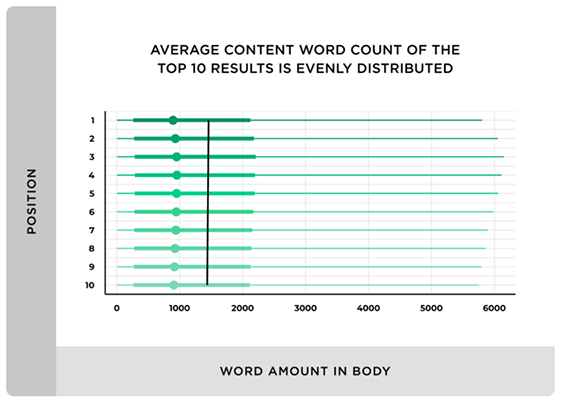
The takeaway: avoid thin content and make sure you’re taking the time to cover a topic in-depth in your blog posts.
12.29% of search query result pages now include featured snippets
Featured snippets are nothing new – they’ve been around since 2014 – but they’ve grown more and more important over the years. In 2020, they’re more relevant to your SEO strategy than ever.
According to a recent study by Ahrefs, 12.29% of all search terms now bring up featured snippets:
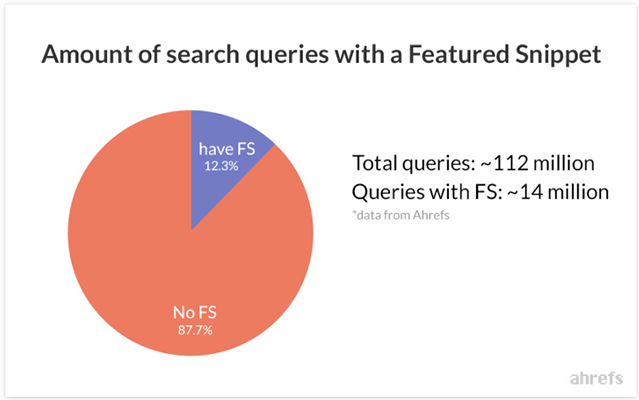
And they’re even more important for voice search. According to a study by Backlinko, a whopping 40.7% of all voice search answers come from featured snippets.
Google’s deep-learning BERT algorithm affects 10% of search queries
The latest information we have on Google’s 2020 BERT update was that the algorithm was being used in 10% of all English search queries in the US.
In case you missed the memo, BERT (Bidirectional Encoder Representations from Transformers) was an update to Google’s search model that aims to improve their understanding of search queries that use natural/conversational language.
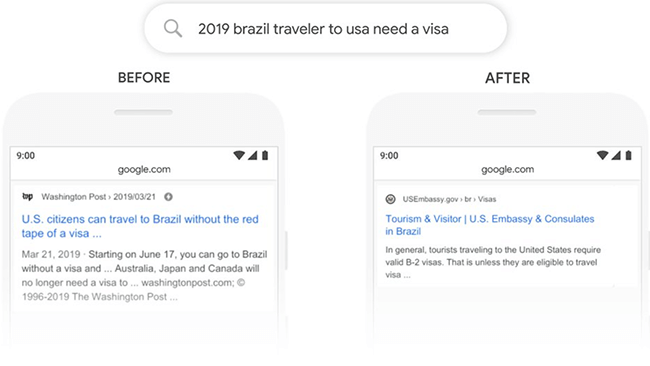
It allows Google to better interpret the nuance and context of the query, and therefore deliver more well-matched search results. It was called the ‘biggest update in 5 years’. (Source: Search Engine Land)
Coronavirus was the top global search term in 2020
No surprises there. The pandemic has dominated headlines this year so, naturally, it’s also dominated search. The other top 5 most popular Google searches were ‘Election results’, ‘Kobe Bryant’, ‘Zoom’, and ‘IPL’. Many SEOs were quick off the mark to cash in on this surge by targeting coronavirus-related keyword search queries in their strategy. (Source: Google Trends)
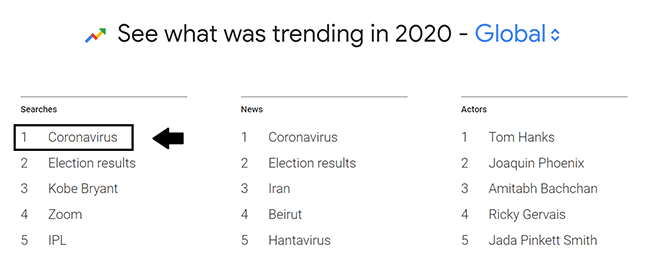
Travel search-demand increased by 30% in 2020 Q3
In similar news, travel-related search queries bounced back in the third quarter of 2020 following an initial dip brought about by COVID-19-related travel restrictions. This is good news for businesses in the travel industry. (Source: Advanced Web Ranking)
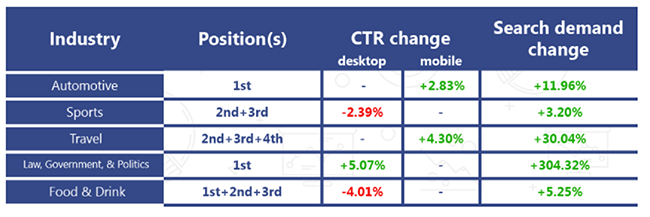
Voice search was predicted to account for 50% of all searches in 2020
Per Comscore. To tap into voice search, aim to write content that answers the questions your customers are asking without getting hung up on specific keywords.
67.6% of all clicks go to the first five organic results
The top-ranking content on the search engine results page continues to amass the vast majority of clicks. With over two-thirds of searchers clicking on one of the top 5 organic results, SEOs really need to be aiming high. If you’re not visible above the fold, you’re not getting the traffic you deserve. (Source: Marketing Land)
15% of all Google search terms have never been searched for before
If you thought there were no keyword gaps left, think again. New juicy keywords that your competitors haven’t already gone after are coming up all the time. This is clear, given that 15% of all search queries are brand new to Google. (Source: Search Engine Land)
Search engine statistics
Now let’s dive into some statistics that tell us more about the search engines most consumers are using to find answers to their queries.
Google commands the largest market share of any search engine (69.3%)
No surprises here then. As expected, Google is still the world’s favorite search engine. It dominates the market with over two-thirds of the market share as of October 2020.
Bing came in second at 13.85%, closely followed by Chinese search engine Baidu at 12.78%. Yahoo trailed behind the pack with a disappointing 1.76%. Note that this isn’t counting video search platforms like YouTube.
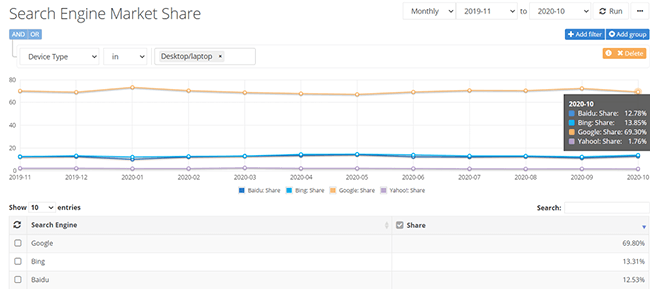
The upshot for marketers is clear: focus on Google. Naturally, you’ll begin to rank on other search engines but the available traffic from smaller platforms such as DuckDuckGo will be negligible. (Source: Net Market Share)
There are over 85,000 Google searches each second
According to Internet Live Stats, there were 88,099 searches per second on the day this post was written. This figure might not be an exact average – Google doesn’t officially share exact numbers – but it’s a pretty good estimate.
In the time it’s taken you to read this, there’s likely already been over a million searches. That should give you some idea of the huge scope there is for SEO.
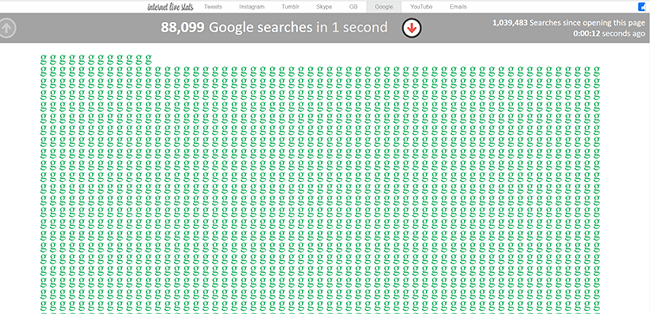
Over 50% of product searches start on Amazon
Google might dominate for general web searches, but Amazon takes the win when it comes to product searches specifically. The shopping platform giant has been slowly increasing its dominance in the product search space, and it now generates more product searches per year than Google. (Source: WebFX)
Related Reading: 17 Crucial Search Engine Statistics (Market Share, Revenue, And More).
SEO marketing statistics
Here are some of the most important statistics for SEO marketers to know.
61% of marketers consider SEO efforts and boosting organic presence their top inbound marketing priority
As this stat from HubSpot shows, SEO is still king when it comes to inbound marketing. More marketers are focused on improving their organic search rankings than any other inbound marketing tactic.
As a side note, if you need help tracking your rankings, check out our post on the best rank tracking tools.
70% of marketers think SEO delivers better results than PPC
SEO is a long-term strategy that generates more leads at a lower cost than paid search – and it doesn’t require you to continually invest in ads. It’s no surprise, then, that marketers are seeing better results from their SEO campaigns than PPC. (Source: Databox)
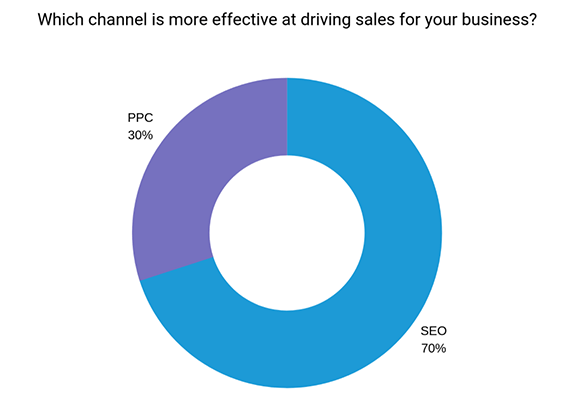
86.5% of SEOs use PPC data to inform their SEO campaigns
Despite the fact that the majority of marketers think SEO delivers better results than PPC, the truth is that both approaches have a place in your marketing strategy. The best results come from taking a strategic, unified approach and integrating both SEO and PPC in your campaigns.
That’s why 86.5% of SEOs feed keyword/conversion data from their PPC efforts into their SEO campaigns. You can also use PPC to test your keyword strategy before implementing long-term SEO efforts.
SEO leads have a close rate of 14.6%
That’s vastly greater than outbound-sourced leads, which have a measly close rate of just 1.7. (Source: HubSpot)
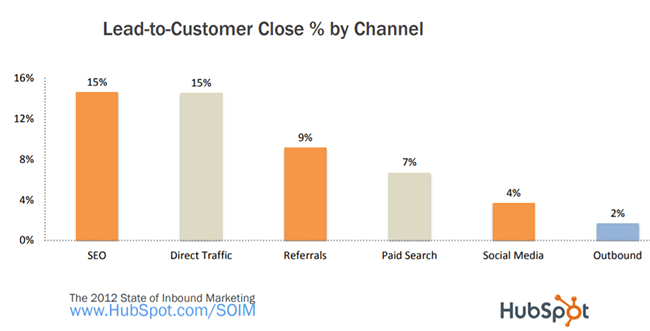
SEO costs statistics
Wondering how much of your marketing budget to allocate to SEO efforts? Here are some statistics about the cost of SEO to help you figure it out.
The majority of professional SEOs charge less than $150/hr
According to data from Ahrefs, $100-$150 is the most popular pricing tier amongst SEOs in the US who charge hourly rates (35.29%), and around 20% of SEOs charge $75-$100 per hour.
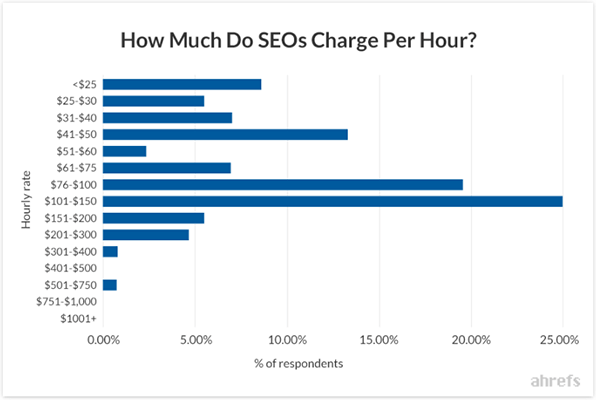
The average SEO per-project pricing is between $501 and $1000
The same data from Ahrefs suggest that around 25% of all SEO projects are priced somewhere in this range.
The role of an SEO requires the use of various tools which would are typically built into this price. For example, tools are typically used to assist with tasks such as keyword research, competitive research, site auditing, rank tracking, and backlink analysis.
Paid backlinks cost $361.44, on average
Building your website authority isn’t cheap. If you plan on purchasing link placements, expect to pay around $361.44 per link. The higher the DA of the site, the higher the cost. (Source: Ahrefs)
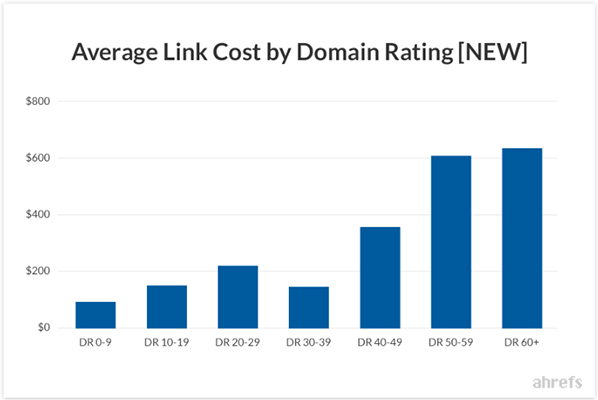
Paid guest posts cost $77.80, on average
Ahref’s also showed that guest posting is another popular link building strategy. Amongst sites that charge for guest posts, the average cost is $77.80.
SEO keyword statistics
Keyword research is still a big part of SEO marketing efforts. Here are some statistics to inform your keyword strategy.
Long-tail keywords have superior CTRs
Long-tail keywords have click-through rates 3-5% greater than regular keywords.
Now, some keyword research tools are better than others for long-tail keywords. We’ve had a positive experience with platforms such as SE Ranking, Serpstat, and Semrush.
(Source: Smart Insights)
Most search phrases are 4 words or more
The idea that shorter search queries have higher search volumes is a myth. Most internet users search for longer phrases of 4+ words. One- and two-word search terms are actually comparatively less common.
The vast majority (92.42%) of keywords have a monthly search volume ≤ 10
These highly specific, unpopular search terms make up around 39% of the total search demand. (Source: Ahrefs)
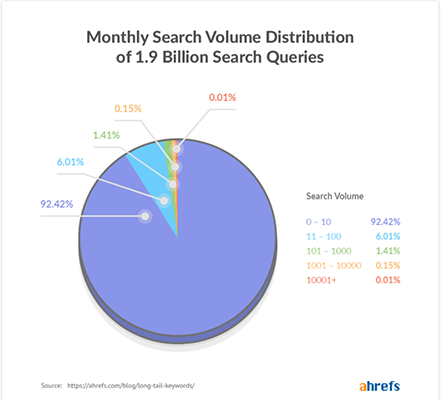
‘How-to cut your hair’ and similar terms saw record search volumes this year
One clear trend marking 2020 was the surge in search volume for DIY beauty how-tos as consumers were forced to adapt to lockdown measures across the globe.
Other how-to terms that saw a notable increase were ‘How to make a facemask’, ‘How to donate to Black Lives Matter’, and ‘How to be an ally’. (Source: Google Trends)
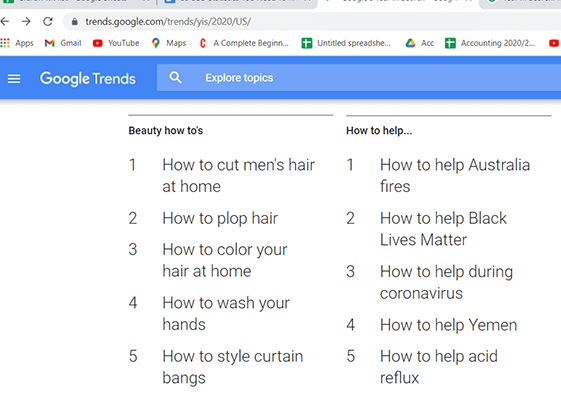
SEO ranking statistics
Getting your content to rank is the ultimate goal of SEO. Here are some statistics that shed light on what it takes to rank in 2020/21.
The most important ranking factor is direct website visits
This is according to the SEMrush ranking factors study 2.0. Other factors that topped the list were time on site, pages per session, bounce rate, and referring domains.
This suggests that Google is placing increasing importance on how users interact with your site. The more engaged they are with your content, and the longer they spend on your site, the more likely you are to rank.
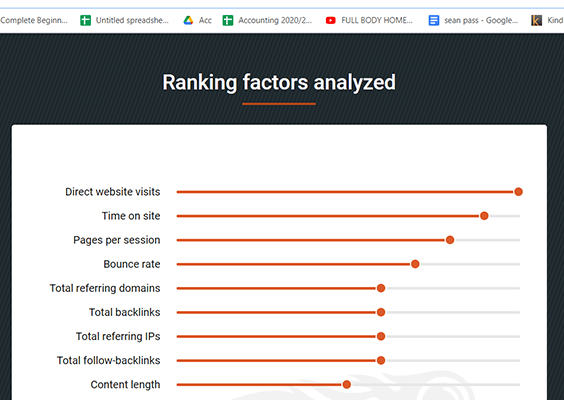
On-page SEO factors are amongst the least important ranking factors
Surprisingly, the same SEMrush study found that keywords were relatively unimportant in ranking position, despite the fact that keyword optimization is one of the most widely adopted SEO techniques.
Including the keyword in anchor, body, title, and meta description, as well as keyword density, were all found to be relatively unimportant.
On a side note, if you need help optimizing your content for search, these on-page SEO tools will help.
The average bounce rate for top-ranking pages is around 50%
If you want to get really specific, it’s actually 49% for pages ranking in position 1 for low-volume keywords, and 51% for those ranking for high-volume keywords. Lower bounce rates are thought to be a key ranking factor on Google. (Source: Backlinko)
#1 ranking pages have 3.8x more backlinks than those in positions 2-10
The same Backlinko source shows that link authority continues to be an important ranking signal for Google. The more backlinks that point to your page, the better chance you stand of landing the top spot.
The average first-page website has a loading speed of 1.65 seconds
Loading speeds have become an increasingly important ranking factor over the years. If you want to land in the top page results, make sure you’re optimizing your site for rapid loading. 1.65 seconds is a useful benchmark to aim for according to the same Backlinko source.
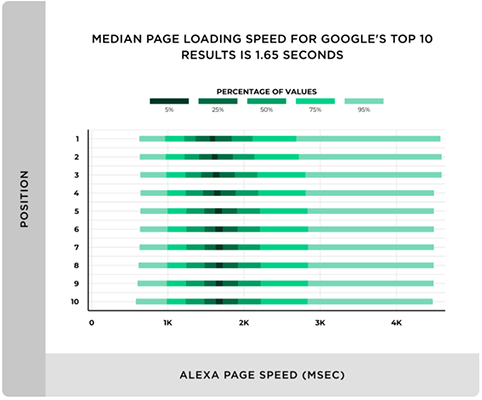
SEO challenges statistics
Nobody said SEO was easy. The statistics below highlight some of the key challenges facing SEOs.
Over 90% of content gets no Google search traffic
This shocking statistic shows just how difficult SEO is to get right. Most of the content businesses spend valuable time and money creating ends up buried in the SERPs thanks to poor SEO.
(Source: Ahrefs)
66.31% of pages have 0 backlinks
This is one of the main reasons many pages fail to rank. A different study from Backlinko (as per statistic 26) put the figure even higher, at a whopping 95%. Of those that do have backlinks, 26.29% have less than 3 different referring domains.
Just 5.7% of pages rank in the top 10 search results rank within the first year
SEO is a long-term strategy – it doesn’t generate instant results like PPC campaigns. As this statistic shows, getting your posts to rank doesn’t happen overnight. (Source: Ahrefs)
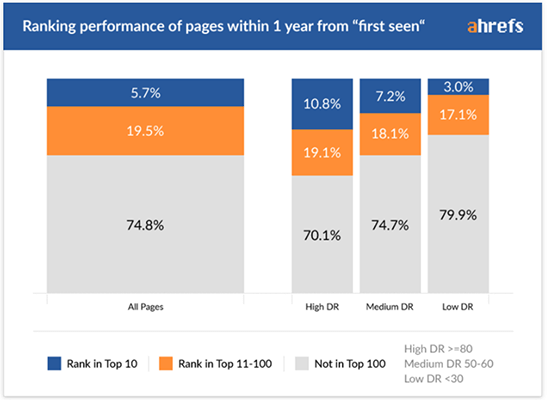
YouTube SEO statistics
When we think of SEO, we usually think about Google. We often forget that YouTube is the second biggest search engine on the internet. Here are some YouTube SEO statistics to inform your video SEO strategy.
YouTube processes 3 billion searches a month
That’s more than Bing, Yahoo!, AOL, and Ask combined. (Source: Mushroom Networks)
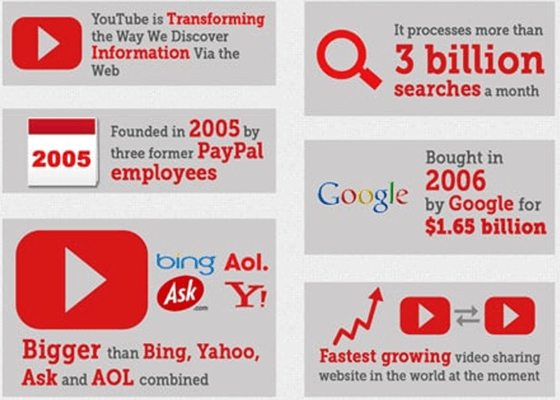
88% of videos that rank on Google also rank on YouTube
According to Perficient, the vast majority of videos ranking on Google also rank in YouTube’s top 10 results for the same search query.
Uploading videos in HD is essential to rank on YouTube
68.2% of the first-page results on YouTube are in HD resolution (1080p or 720p). Lower resolution videos are less likely to rank, so make sure you’re uploading in HD (Source: Backlinko)
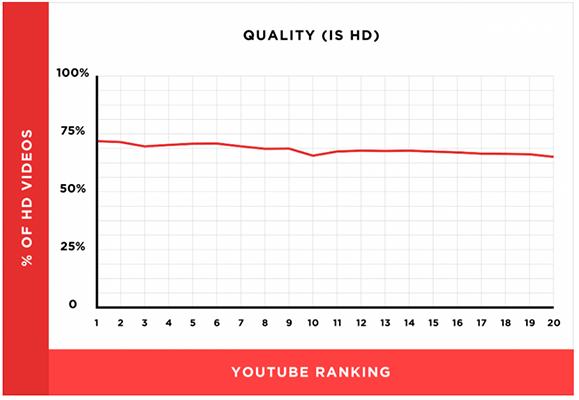
Video engagement signals correlate strongly with higher YouTube rankings
This is from the same study by Backlinko. YouTube’s algorithm seems to place a lot of emphasis on viewer engagement. The upshot: the more likes, comments, and shares a video has, the higher the likelihood it has of ranking.
The average YouTube video length is around 15 minutes
According to the same Backlinko study the average YouTube video is 14 minutes, 50 seconds to be exact. Longer videos seem to outrank shorter videos due to the fact that watch time is one of the most important YouTube ranking factors.
Recommendations are more important than search results
70% of all videos watched on YouTube are driven by YouTube’s recommendation algorithm. This suggests that optimizing your video to appear in the sidebar, homepage, and other recommendation feeds on YouTube is more important than ranking for specific search terms. (Source: Cnet)
Key takeaways
As the above statistics illustrate, SEO continues to be an effective inbound marketing strategy. However, if you want to compete, it’s important for marketers to continue to adapt their strategy alongside evolving consumer search trends and algorithmic updates.
Focus on conversational, long-tail voice search queries, factor snippets into your strategy, continue to devote time and resources to building your website authority and earning backlinks, and don’t overlook video SEO as part of your inbound marketing efforts.
And of course, as always, the most important thing is to make sure you’re creating great content.
But, you’re going to need the right tools for the job. Check out our post on the best SEO software tools to learn more. These tools will help you research topics, track rankings, check backlinks, and more.
Related stats posts you’ll find useful:
